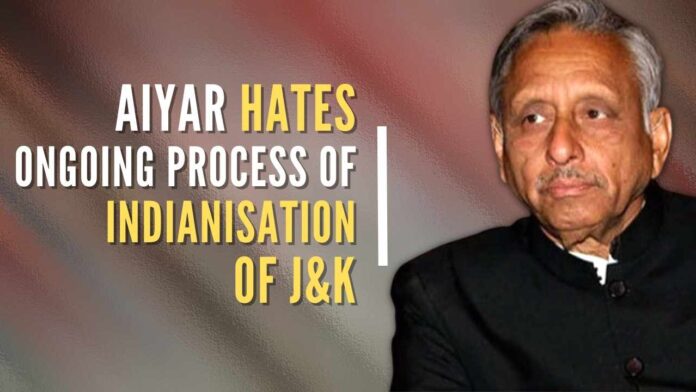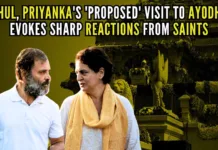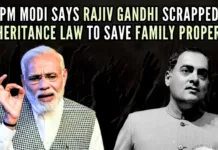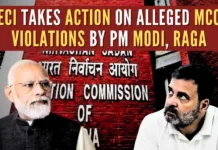
Blend of distortions
Former Congress minister and ideologue of Sonia Congress, Mani Shankar Aiyar, who seeks Pakistan’s support to dislodge the Narendra Modi government and a solution to the so-called Kashmir issue that is acceptable to the aggressor Pakistan, has again penned down an atrocious article on J&K (“All is not well in Jammu and Kashmir”, The Wire, Feb 9, 2023)[1]. It is nothing but a blend of distortions, misrepresentations, wrong comparisons, and threats to the Indian state. He has said many things which clearly suggest that he is divisive and communal and that he hates India and the Indian Constitution, but I will focus only on his five highly objectionable formulations.
Indianisation of J&K alienates Muslims
Aiyar belongs to that perverted school of thought that seeks to force down the nation’s throat the pernicious view that Kashmir means the whole of J&K UT, the Kashmiri Muslims are the sole factor in the region’s political situation, and accepting their demands would be the same as meeting the aspirations, urges needs and compulsions of the people of Jammu province. Put in any amount of effort to find if he wrote even a single word in his lengthy essay on the persecution of a miniscule minority of Hindus in Kashmir and their forcible expulsion in 1990 and the way Kashmiri Muslim leadership ill-treated the Hindus of Jammu and Buddhists of Ladakh between 1947 and 2018, you will come out of the exercise minus everything. So biased is he and so communal is his approach.
The Congress’s ideologue also seeks appreciation of the Kashmiri Muslims’ view that the Narendra Modi government has “captured Kashmir” and “solutions being thrust on them (Muslims) without consultation”. “The principal objective of the reading down of Article 370 (by the Modi government on August 5-6, 2019) has been the shifting of identity from Kashmiri to Indian,” he says. Such is the nature of his hatred for India and things Indian that he asserts in a most brazen manner that “unless current trends at forcibly ‘Indianising’ J&K are reversed, J&K will continue to drift from us”.
What Aiyar says is self-explanatory and needs no further elucidation. Suffice it to say that he, like all other break-India forces, wants the Narendra Modi government to treat J&K as a non-Indian territory and grant it quasi-independent status and give a free hand to Kashmiri Muslim leadership to misrule J&K and subvert the polity as before so that a situation is created that helps Pakistan play nefarious games in the region and make Jammu Hindu-free like they made Kashmir Hindu-free three decades ago.
Kashmiriyat
It’s significant to note that Aiyar, who hates PM Narendra Modi and the BJP from the core of his heart, has praised former PM Atal Bihari Vajpayee because he hailed “Kashmiriyat”. “It is precise because their (Kashmiri Muslims’) distinct identity is so crucial to the Kashmiri that A B Vajpayee’s invocation of ‘Kashmiriyat’ has had so much resonance in Kashmiri hearts,” he wrote in this regard.
What is this Kashmiriyat? Who coined this outrageous term? When and where was it coined? Kashmiriyat means persecution, rigorous exclusion of non-Muslims from all walks of life, and exclusiveness. Some term Kashmiriyat as “Sunniyat”. What the New Delhi-backed Kashmiri ruling elite did to Hindus in Kashmir before and after January 19, 1990, to convert Kashmir constitutes just one example that serves to explain what Kashmiriyat means and what it stands for. The demographic changes caused by it in Jammu province and Ladakh on a massive scale constitute yet another immediate fall-out of Kashmiriyat. One can cite any number of instances that serve to indicate the extent to which the Kashmiriyat caused injuries to the state, the nation, and the non-Muslim minorities in Jammu, Kashmir, and Ladakh.
The term was coined in 1976, only a year after the then PM Indira Gandhi brought back to power the deflated and separatist separatists and fanatic of fanatics Sheikh Abdullah of Kashmir. And, it was coined by a Jammu-based Hindu journalist and the then NC’s vice-president of Jammu province, Balraj Puri, so that the Sheikh could be presented in India as a “secular and democratic leader” and could grind his own personal axe.
Non-existent compact
Aiyar says that “the psychological distancing (read between Kashmiri Muslims and New Delhi) is a reaction to the Union government’s unsubtle attempts at diluting the specific, separate identity of Kashmiris that was critical to the compact of J&K accepting Indian citizenship on the strict condition that to preserve their identity, they would be encouraged to exercise as much autonomy as possible”. “That is the basis of Article 370 elaborated in the Delhi Agreement of 1952 under which the opening article in the J&K constitution proclaims J&K as an integral part of the Indian Union while subsequent articles left J&K far freer than other states in respect of exercising political and administrative authority,” he has further said.
There exists no such compact referred to be Aiyar. The Instrument of Accession signed by Maharaja of J&K, Hari Singh, who alone had the power to decide the political fate of his princely state under the constitutional law on the subject, was hundred percent similar to the one signed by other 560-odd princely states and the accession was permanent and unconditional. The Kashmiri Muslims had no locus standi in the matter. The London-nominated Indian PM J L Nehru only subverted the Indian Independence Act by making Sheikh Abdullah a party to the accession process on October 26, 1947. Indeed, Aiyar murdered history and misrepresented facts to promote separatism and communalism of the worst form. And it was not altogether unexpected of his given his whole concept of India and on India.
Where is Delhi Agreement?
Hardcore supporter of votaries of semi-independent status and self-rule (read Indo-Pak joint control and shared sovereignty) in Kashmir Aiyar further distorts history when he talks about the so-called Delhi Agreement on J&K. There exists no such agreement. And, this truth was acknowledged immediately after the formation of the Farooq Abdullah-led NC government in J&K on October 9, 1996, by none other than finance minister and NC’s ideologue A R Rather in the presence of Farooq Abdullah, all the NC ministers and all the NC legislators at the SKICC, Srinagar, where the then Director Information K B Jandial, was also present. Rather admitted the truth during the last session of the 2-day-long seminar on J&K autonomy, which was chaired by a Delhi-based journalist, the late Praful Bidwai, and he admitted the truth when this writer, who was also participating in the seminar, challenged the NC to show him a copy of “the Delhi Agreement, signed on July 24, 1952, by Nehru and the Sheikh.”
It bears recalling that Farooq Abdullah had repeatedly claimed that “it was parliament which (ratified the ‘Delhi Agreement’ and) promised autonomy” and that “the bill (to this effect was) piloted (on July 24) by (the) then PM, Jawaharlal Nehru”. All this should clear all the cobwebs of confusion and establish that Aiyar only sought to mislead by insisting that the otherwise non-extent Delhi Agreement did promise the maximum possible autonomy to J&K.
Articles 370 and 371: Wrong comparison
In his essay, the essentially divisive and communalist Aiyar claimed that “Article 370 spawned the subsequent Article 371, which makes special provisions for the governance of at least 11 other states, including, interestingly, Gujarat”. Aiyar is right when he claims that Article 371 makes special provisions for 11 other states. No one can contest his claim.
However, Aiyar crosses the red line when he compares Article 371 with Article 370. Article 371, unlike the now-read-down Article 370, doesn’t give any of the 11 states a separate Constitution and flag. Nor does Article 371, unlike Article 370, grants residuary powers to any of these 11 states. But more than that, Article 371, unlike Article 370, doesn’t create an impression that any of these 11 states is not an integral part of India as other states and Union Territories of the country or it is a disputed territory between India and Pakistan or between India and Bangladesh.
Ignored Jammu needs special package
Will Aiyar appreciate all these facts? No, he will not. After all, he has all through extended his unflinching and unqualified support to the ardent believers in the concept of Kashmiri Muslim sub-nationalism and all along penned down articles of promotion of separatism and fanaticism. Hence, his refrain that the Modi government is subverting all the cardinal principles of democracy and secularism and denying the Kashmiri Muslims the right to go out of India’s political and constitutional organization needs to be viewed in this context. The fact of the matter is that it’s the ignored people of the politically marginalized Jammu province who need special care, special attention, and a special package in the form of statehood.
Note:
1. Text in Blue points to additional data on the topic.
2. The views expressed here are those of the author and do not necessarily represent or reflect the views of PGurus.
Reference:
[1] All Is Not Well in Jammu and Kashmir – Feb 09, 2023, The Wire
PGurus is now on Telegram. Click here to join our channel and stay updated with all the latest news and views
For all the latest updates, download PGurus App.
- ‘Kashmir My core constituency’: Revisiting July 12, 2003 to understand politics, Omar Abdullah-style - March 15, 2024
- Total deviation from traditional approach: Seven takeaways from PM Modi’s March 7 Srinagar visit - March 9, 2024
- Status of political parties: Why is further J&K reorganization imperative? - March 1, 2024











MS Iyer is a known anti-India stooge of Pakistan. His words/opinion mean nothing to Indians. He may keep barking.